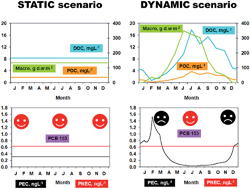当前位置:
X-MOL 学术
›
Environ. Sci.: Processes Impacts
›
论文详情
Our official English website, www.x-mol.net, welcomes your
feedback! (Note: you will need to create a separate account there.)
Do environmental dynamics matter in fate models? Exploring scenario dynamics for a terrestrial and an aquatic system†
Environmental Science: Processes & Impacts ( IF 4.3 ) Pub Date : 2017-12-14 00:00:00 , DOI: 10.1039/c7em00530j Melissa Morselli 1, 2, 3, 4 , Elisa Terzaghi 1, 2, 3, 4 , Antonio Di Guardo 1, 2, 3, 4
Environmental Science: Processes & Impacts ( IF 4.3 ) Pub Date : 2017-12-14 00:00:00 , DOI: 10.1039/c7em00530j Melissa Morselli 1, 2, 3, 4 , Elisa Terzaghi 1, 2, 3, 4 , Antonio Di Guardo 1, 2, 3, 4
Affiliation

|
Nowadays, there is growing interest in inserting more ecological realism into risk assessment of chemicals. On the exposure evaluation side, this can be done by studying the complexity of exposure in the ecosystem, niche partitioning, e.g. variation of the exposure scenario. Current regulatory predictive approaches, to ensure simplicity and predictive ability, generally keep the scenario as static as possible. This could lead to under or overprediction of chemical exposure depending on the chemical and scenario simulated. To account for more realistic exposure conditions, varying temporally and spatially, additional scenario complexity should be included in currently used models to improve their predictive ability. This study presents two case studies (a terrestrial and an aquatic one) in which some polychlorinated biphenyls (PCBs) were simulated with the SoilPlusVeg and ChimERA models to show the importance of scenario variation in time (biotic and abiotic compartments). The results outlined the importance of accounting for planetary boundary layer variation and vegetation dynamics to accurately predict air concentration changes and the timing of chemical dispersion from the source in terrestrial systems. For the aquatic exercise, the results indicated the need to account for organic carbon forms (particulate and dissolved organic carbon) and vegetation biomass dynamics. In both cases the range of variation was up to two orders of magnitude depending on the congener and scenario, reinforcing the need for incorporating such knowledge into exposure assessment.
中文翻译:

命运模型对环境动力学有影响吗?探索陆地和水生系统的场景动态†
如今,越来越多的兴趣将更多的生态现实主义插入化学物质的风险评估中。在暴露评估方面,这可以通过研究生态系统中暴露的复杂性,生态位划分来完成,例如暴露场景的变化。为了确保简单性和预测能力,当前的监管预测方法通常将场景保持尽可能静态。根据模拟的化学药品和情景,这可能导致化学药品暴露的低估或高估。为了考虑到更现实的暴露条件,随时间和空间的变化,当前使用的模型应包括其他场景复杂性,以提高其预测能力。这项研究提出了两个案例研究(陆生和水生研究),其中一些土壤中的多氯联苯(PCBs)用SoilPlusVeg和ChimERA模型进行了模拟,以显示情景随时间变化的重要性(生物区隔和非生物区隔)。结果概述了考虑行星边界层变化和植被动力学以准确预测空气浓度变化和来自陆源的化学扩散时间的重要性。对于水上运动,结果表明需要考虑有机碳形式(颗粒和溶解的有机碳)和植被生物量动态。在这两种情况下,变化的范围取决于同类和情景,最多可达两个数量级,从而增加了将此类知识纳入暴露评估的必要性。结果表明需要考虑有机碳形式(颗粒状和溶解性有机碳)和植被生物量动态。在这两种情况下,变化的范围取决于同类和情景,最多可达两个数量级,从而增加了将此类知识纳入暴露评估的必要性。结果表明需要考虑有机碳形式(颗粒状和溶解性有机碳)和植被生物量动态。在这两种情况下,变化的范围取决于同类和情景,最多可达两个数量级,从而增加了将此类知识纳入暴露评估的必要性。
更新日期:2017-12-14
中文翻译:

命运模型对环境动力学有影响吗?探索陆地和水生系统的场景动态†
如今,越来越多的兴趣将更多的生态现实主义插入化学物质的风险评估中。在暴露评估方面,这可以通过研究生态系统中暴露的复杂性,生态位划分来完成,例如暴露场景的变化。为了确保简单性和预测能力,当前的监管预测方法通常将场景保持尽可能静态。根据模拟的化学药品和情景,这可能导致化学药品暴露的低估或高估。为了考虑到更现实的暴露条件,随时间和空间的变化,当前使用的模型应包括其他场景复杂性,以提高其预测能力。这项研究提出了两个案例研究(陆生和水生研究),其中一些土壤中的多氯联苯(PCBs)用SoilPlusVeg和ChimERA模型进行了模拟,以显示情景随时间变化的重要性(生物区隔和非生物区隔)。结果概述了考虑行星边界层变化和植被动力学以准确预测空气浓度变化和来自陆源的化学扩散时间的重要性。对于水上运动,结果表明需要考虑有机碳形式(颗粒和溶解的有机碳)和植被生物量动态。在这两种情况下,变化的范围取决于同类和情景,最多可达两个数量级,从而增加了将此类知识纳入暴露评估的必要性。结果表明需要考虑有机碳形式(颗粒状和溶解性有机碳)和植被生物量动态。在这两种情况下,变化的范围取决于同类和情景,最多可达两个数量级,从而增加了将此类知识纳入暴露评估的必要性。结果表明需要考虑有机碳形式(颗粒状和溶解性有机碳)和植被生物量动态。在这两种情况下,变化的范围取决于同类和情景,最多可达两个数量级,从而增加了将此类知识纳入暴露评估的必要性。











































 京公网安备 11010802027423号
京公网安备 11010802027423号